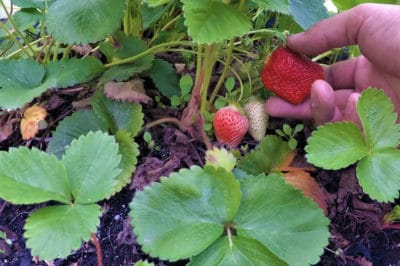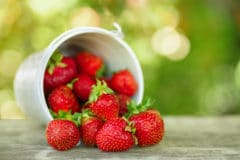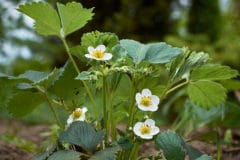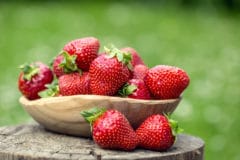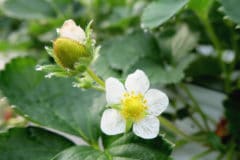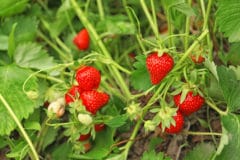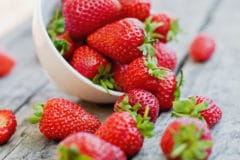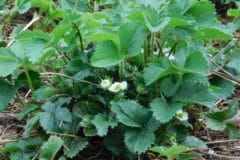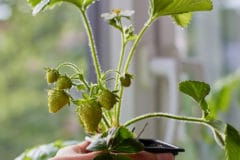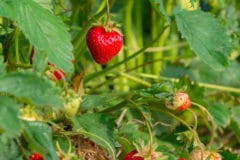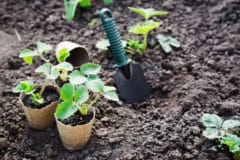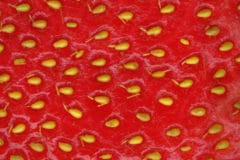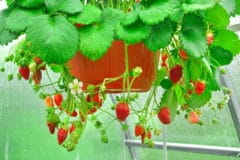Strawberry Growing Basics
Strawberries are perennial forbs that spread primarily through their runners. They do best in rich, loose soil that drains well and if drainage is a problem, use raised beds. A mulch helps hold moisture and keeps berries clean. They can be grown in USDA Zones 3 to 10, although planting times are later in colder areas. Most gardeners remove the plants after the third year due to disease problems.
Everbearing Varieties
Everbearing is a bit of a misnomer with these strawberries. They actually bear two crops a year in most cases – a spring crop and a late summer or fall crop. They produce fewer runners, so they reproduce more slowly. These are possibilities:
- Alexandria
- Arapahoe
- Baron Solemacher
- Bolero
- Calypso
- Fort Laramie
- Ogallalla
- Ozark Beauty.
Day-Neutral Varieties
Temperature is what matters with these varieties, not day length. They will produce as long as temperatures range between 35 and 85°F (2 and 29°C). Often planted in maritime areas, their fruit is smaller than that of other types. Try these varieties:
- Albion
- Alinta
- Seascape
- Selva
- Tribute
- Tristar.
June Bearing Varieties
June bearing strawberries, as the name implies, tend to produce fruit in or near June. They bear only once a year, but typically produce larger berries than other types. These varieties are readily available:
- Allstar
- Cabot
- Clancy
- Earliglow
- Honyoe
- Jewel
- Sparkle
- Surecrop.
When to Pick
When you pick will depend on whether your plants are June bearers, day neutrals or everbearers. In general, berries appear about four to six weeks after the plants bloom. If you plan to use the fruit immediately, you can pick at any time of day. If you want to store the fruit for a few days, it’s better to pick early in the morning.
How to Judge Ripeness
Color is the primary key to ripeness. A strawberry that is not completely red or that has yellow or green spots is not fully ripe. You want to catch the berry when it is a full, deep red and the surface is slightly shiny. With a variety that you haven’t grown before, you’ll have to pick a few and taste. Expose partly ripe berries to more sunlight to hasten ripening.
Picking Considerations
Some strawberries – Surecrop is an example – snap off easily with a portion of stem still attached. Others, like Sparkle, must have the stem pinched or cut off to prevent them from bruising. Berries that cap easily – pull loose leaving a little of the green calyx attached – should be used immediately as they will not store well. Capping is not specific to certain varieties.
Choosing Containers
Deep containers increase the risk that strawberries on the bottom will be smashed; the fruit is quite fragile. Your containers should be no more than five inches deep. Loosely woven flat baskets or the plastic open-work boxes found in grocery stores make good containers. Strawberry juice will stain, so consider that factor when choosing containers.
How to Pick
Using the forefinger and thumbnail of one hand, grasp the stem just above the berry. Gently pull with a slight twisting motion. The stem should break about half an inch above the berry. Allow the berry to roll into your palm. Once you have three or four berries in each hand, gently place the fruit into the containers. Pay attention as you move to the next plant not to step or kneel on plants and berries.
As You Pick
Make sure to check under leaves as you move down the row. Ripe berries are often found hiding under leaves. Remove any berries that have been damaged by insects or that are over-ripe, as they can affect further fruit set and increase the risk of disease. Berries that show signs of rot or sunburn should also be removed. Pick the entire row except for unripe berries.
Storing Fresh-Picked Strawberries
It’s best to store only those strawberries picked first thing in the morning. Cool them quickly and don’t allow them to sit in the sun after picking. You can usually keep them in the refrigerator for three or four days; after that they tend to shrivel and become soft. Don’t wash the berries until just before you use them, as it encourages rot.
